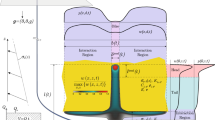Abstract
Fracture network modelling plays an important role in many application areas in which the behaviour of a rock mass is of interest. These areas include mining, civil, petroleum, water and environmental engineering and geothermal systems modelling. The aim is to model the fractured rock to assess fluid flow or the stability of rock blocks. One important step in fracture network modelling is to estimate the number of fractures and the properties of individual fractures such as their size and orientation. Due to the lack of data and the complexity of the problem, there are significant uncertainties associated with fracture network modelling in practice. Our primary interest is the modelling of fracture networks in geothermal systems and, in this paper, we propose a general stochastic approach to fracture network modelling for this application. We focus on using the seismic point cloud detected during the fracture stimulation of a hot dry rock reservoir to create an enhanced geothermal system; these seismic points are the conditioning data in the modelling process. The seismic points can be used to estimate the geographical extent of the reservoir, the amount of fracturing and the detailed geometries of fractures within the reservoir. The objective is to determine a fracture model from the conditioning data by minimizing the sum of the distances of the points from the fitted fracture model. Fractures are represented as line segments connecting two points in two-dimensional applications or as ellipses in three-dimensional (3D) cases. The novelty of our model is twofold: (1) it comprises a comprehensive fracture modification scheme based on simulated annealing and (2) it introduces new spatial approaches, a goodness-of-fit measure for the fitted fracture model, a measure for fracture similarity and a clustering technique for proposing a locally optimal solution for fracture parameters. We use a simulated dataset to demonstrate the application of the proposed approach followed by a real 3D case study of the Habanero reservoir in the Cooper Basin, Australia.







Similar content being viewed by others
References
Baisch S, Weidler R, Vörös R, Wyborn D, de Graaf L (2006) Induced seismicity during the stimulation of a geothermal HFR reservoir in the Cooper Basin, Australia. Bull Seismol Soc Am 96(6):2242–2256
Billaux D, Chiles JP, Hestir K, Long J (1989) Three-dimensional statistical modelling of a fractured rock mass—an example from the Fanay-Augères mine. Int J Rock Mech Min Sci Geomech Abstr 26(3/4):281–299
Chilès JP, Delfiner P (1999) Geostatistics: modeling spatial uncertainty. Wiley, New York, p 695
Dershowitz WS, Einstein HH (1988) Characterizing rock joint geometry with joint system models. Rock Mech Rock Eng 21:21–51
Dowd PA, Xu C, Mardia KV, Fowell RJ (2007) A comparison of methods for the simulation of rock fractures. Math Geol 39:697–714
Eisner L, Williams-Stroud S, Hill A, Duncan P, Thornton M (2010) Beyond the dots in the box: microseismicity-constrained fracture models for reservoir simulation. Lead Edge 29(3):326–333. doi:10.1190/1.3353730
Gringarten E (1997) 3D geometric description of fractured reservoirs. In: Baafi EY, Schofield NA (eds) Geostatistics Wollongong’96, vol 1. Kluwer Academic, Dordrecht, pp 424–432
Kirkpatrick S, Gelatt CD, Vecchi MP (1983) Optimization by simulated annealing. Science 220:671–680
Kulatilake PHSW, Wathugala DN, Stephansson O (1993) Joint network modelling with a validation exercise in Stripa Mine, Sweden. Int J Rock Mech Min Sci 30:503–526
Lantuéjoul C (2002) Geostatistical simulation, models and algorithms. Springer, Berlin
Lee JS, Veneziano D, Einstein HH (1990) Hierarchical fracture trace model. In: Hustrulid W, Johnson GA (eds) Rock contributions and challenges, proceeding. 31st US Rock Mechanics Symposium, Balkema, Rotterdam, pp 261–268
Mardia KV, Nyirongo VB, Walder AN, Xu C, Dowd PA, Fowell RJ, Kent JT (2007a) Markov chain Monte Carlo implementation of rock fracture modelling. Math Geol 39:355–381
Mardia KV, Walder AN, Xu C, Dowd PA, Fowell RJ, Nyirongo VB, Kent JT (2007b) A line finding assignment problem and rock fracture modelling. In: Upadhaya SK, Singh U, Dey DK (eds) Bayesian statistics and its applications. Anamaya Pubs, New Delhi, pp 319–330
Metropolis N, Rosenbluth AW, Rosenbluth MN, Teller AH, Teller E (1953) Equation of state calculations by fast computing machines. J Chem Phys 21(6):1087
Meyer T, Einstein HH (2002) Geologic stochastic modeling and connectivity assessment of fracture systems in the Boston area. Rock Mech Rock Eng 35(1):23–44
Oda M, Hatsuyama Y, Ohnishi Y (1987) Numerical experiments on permeability tensor and its application to jointed granite at Stripa mine, Sweden. J Geophys Res 92:8037–8048
Rawnsley K, Wei L (2001) Evaluation of a new method to build geological models of fractured reservoirs calibrated to production data. Pet Geosci 7:23–33
Sausse J, Dezayes C, Dorbath L, Genter A, Place J (2010) 3D model of fracture zones at Soultz-sous-Forêts based on geological data, image logs, induced microseismicity and vertical seismic profiles. Comptes Rendus Geosci 342:531–545
Stoyan D, Kendall W, Mecke J (1995) Stochastic geometry and its applications, 2nd edn. Wiley, Chichester
Wen R, Sinding-Larsen R (1997) Stochastic modelling and simulation of small faults by marked point processes and kriging. In: Baafi EY, Schofield NA (eds) Geostatistics Wollongong’96, vol 1. Kluwer Acad, Dordrecht, p 643
Xu C, Dowd PA, Mardia KV, Fowell RJ, Taylor CC (2007) Simulating correlated marked point processes. J Appl Statistics 34:1125–1134
Xu C, Dowd PA, Wyborn D (2013) Optimization of a stochastic rock fracture model using Markov chain Monte Carlo simulation, Mining Technology (in press). doi:10.1179/1743286312Y.0000000023
Acknowledgments
The work reported in this paper was funded by Australian Research Council (ARC Discovery Project) Research Grant Number: DP110104766.
Author information
Authors and Affiliations
Corresponding author
Rights and permissions
About this article
Cite this article
Seifollahi, S., Dowd, P.A., Xu, C. et al. A Spatial Clustering Approach for Stochastic Fracture Network Modelling. Rock Mech Rock Eng 47, 1225–1235 (2014). https://doi.org/10.1007/s00603-013-0456-x
Received:
Accepted:
Published:
Issue Date:
DOI: https://doi.org/10.1007/s00603-013-0456-x




